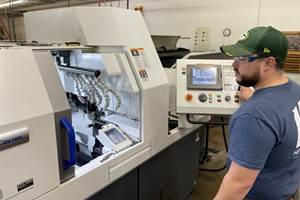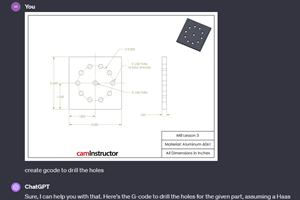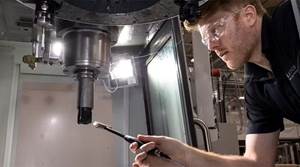Software Becomes The Backbone Of CNC Machining
This company is a medium-sized CNC precision engineering job shop with 17 CNC machines installed. The company specializes in tight tolerance batch work for clients in the aerospace, instrumentation, medical and computer peripheral supply sectors.
Share





Penco Precision (Fontana, California), founded in 1975, is a medium-sized CNC precision engineering job shop with 17 CNC machines installed. The company specializes in tight tolerance batch work for clients in the aerospace, instrumentation, medical and computer peripheral supply sectors. Batch quantities go from a few to several hundred, with a lot falling between five and 25 parts. Tolerances are held as tight as 0.0002 inch on turned diameters up to 0.75 inch and positional tolerances to 0.001 inch. Occasionally, a true position (TP) feature is required when milling, which then demands precise and careful handling.
Since Penco acquired its first CNC machine in 1984, the plant has grown to eight CNC lathes and nine machining centers. Turning capacity up to 6 inches diameter by 15 inches length and machining center capacity up to 24 inches by 36 inches by 18 inches is now available. Machines include a CNC sliding head lathe specifically for slender shaft work and one lathe with Caxis capability. Other facilities include a 3D coordinate-measuring machine and a computerized job scheduling system, while the inhouse quality systems are ISO 9002 compliant.
Penco used to develop part programs using fairly basic methods, according to Glynn Pennington, president. "The only offline facility that we had was a simple computer based text editor," he says. "The pressure to upgrade came from two directions. First, we were being asked to machine more complicated radius and blend features; second, as the number of machines increased so did the programming workload, which was increased due to the trend for short batch demand."
Penco is an unusual company as it has a broad base of CNC skills. Out of a total workforce of 30, nearly half can perform programming, setups and operate the machines. When selecting an offline system, the requirement was for software that could be used with multiple skill levels according to the operational needs of the job and the knowledge of the individual.
At this time, CAM software that had been developed from the ground up in the Windows environment was rare. This was a big factor in Mr. Pennington's ultimate decision to purchase EdgeCAM from Pathtrace Systems Inc. (now Planit). The company bought two seats and hosts one on a desktop PC while the other resides on a notebook. This allows programming to be carried out at home—a practice the company has found to be very successful.
"We've gained all of the benefits that we hoped for with EdgeCAM," says Mr. Pennington. "It has allowed us access to new markets because we are now able to tackle more complex work. In addition, the basic ability to develop programs so much faster has made us more competitive. On the technology front, the DXF and IGES file transfer capability means we can work direct from clients' latest design files rather than from drawings."
Other benefits gained since the introduction of EdgeCAM have included a reduction in the need for hand finishing of components on blends and transitions. In addition to the increased business that has been brought in, it has also acted as a confidence builder for the staff, Mr. Pennington maintains.
"We've been able to develop far more complex programs very quickly and shorten the time to produce quotes for customers. Our `Right First Time' ability has also improved because EdgeCAM helps us to catch errors long before we start to cut metal," he adds.
"We've been able to grow with our customers in a way that would have been impossible without CAD/CAM capability," Mr. Pennington says. "Since we've had EdgeCAM the business has grown, while up to 40 percent of our revenues depend on the capabilities it provides."
Related Content
ERP Provides Smooth Pathway to Data Security
With the CMMC data security standards looming, machine shops serving the defense industry can turn to ERP to keep business moving.
Read MoreCan ChatGPT Create Usable G-Code Programs?
Since its debut in late 2022, ChatGPT has been used in many situations, from writing stories to writing code, including G-code. But is it useful to shops? We asked a CAM expert for his thoughts.
Read MoreCutting Part Programming Times Through AI
CAM Assist cuts repetition from part programming — early users say it cuts tribal knowledge and could be a useful tool for training new programmers.
Read MoreHow to Mitigate Chatter to Boost Machining Rates
There are usually better solutions to chatter than just reducing the feed rate. Through vibration analysis, the chatter problem can be solved, enabling much higher metal removal rates, better quality and longer tool life.
Read MoreRead Next
AMRs Are Moving Into Manufacturing: Considerations for Implementation
AMRs can provide a flexible, easy-to-use automation platform so long as manufacturers choose a suitable task and prepare their facilities.
Read MoreLast Chance! 2025 Top Shops Benchmarking Survey Still Open Through April 30
Don’t miss out! 91ÊÓƵÍøÕ¾ÎÛ's Top Shops Benchmarking Survey is still open — but not for long. This is your last chance to a receive free, customized benchmarking report that includes actionable feedback across several shopfloor and business metrics.
Read MoreMachine Shop MBA
Making Chips and 91ÊÓƵÍøÕ¾ÎÛ are teaming up for a new podcast series called Machine Shop MBA—designed to help manufacturers measure their success against the industry’s best. Through the lens of the Top Shops benchmarking program, the series explores the KPIs that set high-performing shops apart, from machine utilization and first-pass yield to employee engagement and revenue per employee.
Read More





















